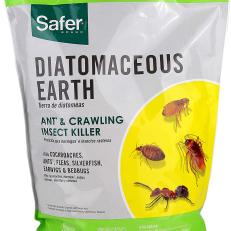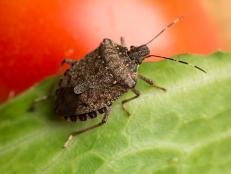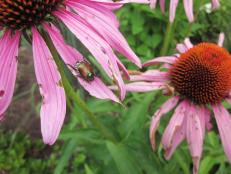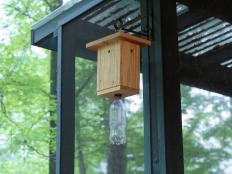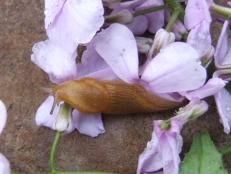How to Get Rid of Earwigs
Earwigs aren't pretty, and they can eat your plants and invade your home. Learn how to make earwigs bug off.

National Gardening Association
If you’re concerned how to get rid of earwigs, consider that they don’t usually cause much damage. But you may want to act when their numbers explode, which can happen during periods of wet, mild weather.

Earwig bugs look creepy, but in small numbers they can actually benefit your garden. In large numbers, they're pests on your plants and in your home. Learn when you really need to worry about how to get rid of earwigs.
Earwigs are natural composters when they eat dead or decaying matter, and as long as bug populations stay in balance, they can help eliminate pests like aphids, maggots and armyworms. If you’re wondering how to get rid of earwigs, consider that they don’t usually cause much damage. But you may want to act when their numbers explode, which can happen during periods of wet, mild weather.
What are Earwigs?
Earwigs are insects that inhabit our gardens and moist, cool places in our homes. They have six legs, two antennae and pincers (appendages known as cerci) that give them their nickname — pincher bugs. Their three-part bodies are elongated, 1/4 to one inch long, and range from brown to black.

Julie Martens Forney
Earwigs scavenge and consume decaying organic matter and eat other plant pests. But when populations are high, they can damage desirable plants by feeding on the soft tissue of seedlings, new shoots and flower petals.
There are 2,000 species in the world; they live everywhere except the polar regions. The most common pincher bug in North America is the non-native European earwig (Forficula auricularia).
Earwigs rarely fly. They’re nocturnal bugs that hide during the day and emerge at night to feed not only in gardens but in bathrooms, crawl spaces, basements and other damp, cool places. These omnivores feed on almost anything, including fruits, foliage, slugs, snails and other insects as well as wet, rotting wood. They also eat living and dead or decaying flower and vegetable plants.
When they enter your home through cracks, holes or gaps, they’re a nuisance . But they rarely cause significant harm and their presence can actually tip you off to moisture damage you hadn’t noticed.
Earwigs don’t spread disease or bite, and their pinches don’t really hurt. Overall, earwig bugs don’t have a big impact on the ecology or cause major economic damage, so don’t fret too much over how to get rid of earwigs.
And that old story about how earwigs can crawl into your ear? Highly unlikely.
How to Find Earwigs in The House
Before you can get rid of earwigs in your house, you must find them. Use a flashlight to look for pincher bugs while they’re active at night. Check any areas where the air is cool and where water might leak or accumulate, like kitchens, laundry rooms, bathrooms, basements and around outdoor faucets and air-conditioning units. At night, they’re often drawn to porch and patio lights, so check under outdoor cushions and flowerpots during the day.

Whiteney Cranshaw/Colorado State University/Bugwood.org
Nocturnal earwigs hide during the day and emerge at night to feast on plants and insects.
You can also smell earwig bugs. They emit a yellowish-brown liquid with a strong, foul odor when disturbed or squashed.
How to Find Earwigs in Your Garden
Go out at night with a flashlight to look for pincher bugs under and on decaying plants, in fallen leaves and under pots. Marigolds, potatoes, lettuce, celery, beans, squash and dahlias are some of their favorite plants. They make jagged holes in foliage that’s often mistaken for slug or snail damage, leaving the plants looking ragged. They often leave excrement, too, in the form of tiny, black pellets.
How to Get Rid of Earwigs With a Trap
Look for ways to kill earwigs that won’t upset your garden’s ecology, like one of these earwig trap ideas:
- Roll or crumple up a few pages of slightly moist newspaper and put them around your garden after dark. The next day, put all the papers into an empty bucket — no need to open them. Drown the pincher bugs by filling the bucket with hot soapy water.
- Fill a can or other container half full of soapy water. Bury it near the earwigs, keeping the rim at ground level. Rub a little oil inside the can, just under the rim, or put a few drops in the water. Earwigs will crawl in and drown.
- Trap earwig bugs by laying 12-inch sections of garden hose or bamboo between your plants. Each morning, scoop up the earwigs trapped between the sections and drown them in soapy water.
- Mix olive oil and soy sauce in a small container and put it where earwigs can smell it. The pincher bugs will climb in and drown, unable to escape the oil.
How to Get Rid of Earwigs in Other Ways
- In dry weather, pull back any mulch around plants plagued by earwigs and sprinkle diatomaceous earth around them. This finely powdered dust scratches their soft body parts and kills earwigs by dehydration. Follow all label directions for using it, as it can be harmful if inhaled.
- Mix dishwashing soap and water, and spray areas where earwigs hang out.
- Kill earwigs on contact by spraying them with a mixture of equal parts of 70 percent rubbing alcohol and water. Note: Spray just one leaf of a plant before treating the entire plant and wait 24 hours to be sure it won’t cause damage.
- Use boric acid, sold at hardware stores, in areas where you’ve seen earwigs. Do not use it near small children, pets or other animals as it can be harmful.
- Use a pesticide labeled for earwig control. Be safe, and follow all label directions, which may include using these products only outside your home.
- Invite natural earwig predators like birds and toads to your garden.
- Vacuum up pincher bugs and any eggs you see.
How to Keep Earwigs From Coming Back
- Repair holes in window screens.
- Seal cracks and gaps around your doors, foundation and vents.
- Repair leaks.
- Remove piles of wood, leaves and rocks.
- Keep mulch and vegetation at least six to 12 inches away from your house.
- Trim trees and bushes to eliminate heavy shade and dampness around the yard.
- Use a dehumidifier to keep excess moisture out of your basement.
- Keep drains and gutters clear.
- Need more help? Call an exterminator.






